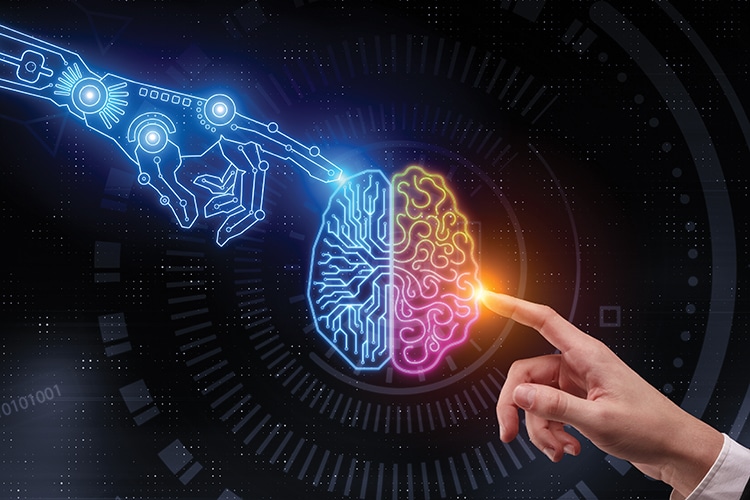What concept led to the development of artificial intelligence?
The British logician and computer pioneer Alan Mathison Turing produced the earliest significant work on artificial intelligence in the middle of the 20th century. In 1935, Turing wrote about an abstract computer that had an infinite memory and a scanner that moved symbol by symbol across the memory, reading what it found and writing new symbols. A program of instructions that is also stored in the memory as symbols controls how the scanner behaves. “What we want is a machine that can learn from experience”, Turing said in what is likely the first public presentation about artificial intelligence (London, 1947). He added that “the possibility of letting the machine alter its own instructions provides the key to understanding the nature of artificial intelligence.”
AI grew significantly between 1957 and 1974. Computers improved in speed, affordability, and accessibility while being able to store more data. Additionally, machine learning algorithms developed, and individuals became more adept at determining which method to use for a given situation. These accomplishments persuaded governmental organizations like the Defense Advanced Research Projects Agency (DARPA) to support AI research at a number of institutions, in addition to the advocacy of top researchers (namely the DSRPAI attendees). Expectations were very high, and optimism was also very strong. According to a statement made by Marvin Minsky to Life Magazine in 1970, “from three to eight years we will have a machine with the general intelligence of an average human being.” Although the fundamental confirmation of the theory was present, there was still a long way to go before the end. Numerous academics and scientists have worked on developing AI since Turing’s time. In fields including machine learning, natural language processing, computer vision, and robotics, the field has made considerable strides. It’s critical to remember that the science of artificial intelligence has developed through time as different methods and strategies have been investigated. From simple rule-based systems to intricate neural networks and deep learning algorithms, AI spans a wide spectrum of technologies and applications. Even now, research and development are still being done to improve the capabilities of intelligent systems in the objective of building AI. Today, AI is used in a variety of areas of our lives, such as virtual assistants, recommendation tools, self-driving cars, and more.
Although there isn’t a single “first” thought that gave rise to artificial intelligence, Turing’s notion and subsequent contributions from researchers around the globe have influenced the field and pushed us closer to fulfilling the potential of AI.
Use of AI
Artificial intelligence (AI) is employed in many different fields and industries and has a wide range of applications. Here are a few typical applications of AI:
- Automation: AI makes it possible to automate tedious and repetitive processes, freeing up human resources for more difficult and innovative work. This includes robotic process automation, autonomous cars, and automated customer care chatbots.
- Natural Language Processing (NLP): NLP is a branch of AI that enables computers to comprehend, interpret, and produce human language. Virtual assistants, voice recognition software, language translation, and sentiment analysis all make use of this technology.
- Image and Video Analysis: AI is capable of deciphering and analyzing photos and videos, which enables functions like facial recognition, object detection, content moderation, and medical imaging analysis.
- Recommendation Systems: To generate individualized suggestions, AI systems examine user preferences, behavior, and historical data. Streaming services, e-commerce sites, and content platforms all frequently exhibit this.
- Healthcare & Medicine: Precision medicine, drug discovery, patient monitoring, and medical diagnostics all use AI. It can support medical research, aid in diagnosis, and help find patterns and trends in vast amounts of medical data.
- Financial Services: AI is used in risk analysis, algorithmic trading, fraud detection, and credit rating. It aids in the analysis of enormous amounts of financial data, the discovery of anomalies, and the generation of forecasts for investment decisions.
- Personalization and marketing: By examining client information, behavior, and preferences, AI provides individualized experiences. It enables companies to send targeted adverts, make product recommendations, and alter user interfaces.
- Cybersecurity: AI improves security measures by quickly identifying and countering online threats. To stop assaults, it can spot trends, oddities, and potential vulnerabilities.
- Education: AI-based applications support individualized tutoring, adaptive learning, and adaptable educational systems that cater to the demands of each individual student.
- Manufacturing and Logistics: AI-based robots, computer vision, and machine learning technologies improve supply chain management, automate quality control, and optimize manufacturing processes.
These are only a few applications of artificial intelligence. With the development of technology and the emergence of new opportunities, AI’s potential applications are numerous and constantly growing.
What about machine learning? How is it related to artificial intelligence?
A branch of artificial intelligence (AI) known as machine learning is concerned with creating models and algorithms that enable computers to learn and make predictions or judgments without being explicitly programmed. In other words, machine learning makes it possible for computers to gain knowledge from data and develop their capabilities over time. The relationship between machine learning and artificial intelligence (AI) derives from the fact that AI systems absolutely require machine learning techniques and algorithms. AI systems may acquire knowledge, spot patterns, and base predictions or choices on data using machine learning’s tools and techniques.
Machine learning algorithms are frequently used by AI systems to process and analyze massive volumes of data, derive valuable insights, and make deft decisions. In order to execute tasks like image identification, natural language processing, speech recognition, recommendation systems, and many more, machine learning models may learn from previous data, discover trends, and utilize this information. The numerous forms of machine learning algorithms include reinforcement learning, unsupervised learning, and supervised learning. Training a model on labeled data, where the desired output is known, is known as supervised learning. In unsupervised learning, correlations and patterns are found in unlabeled data. In order to interact with the environment, learn from feedback (rewards or penalties), and gradually increase performance, an agent must be trained using reinforcement learning. The objective is to develop intelligent computers that can adapt, learn, and make decisions based on data-driven insights by integrating machine learning techniques into AI systems. AI systems can handle difficult tasks, process enormous volumes of data, and continuously learn and adapt to enhance their performance thanks to machine learning, which is a vital instrument in this process.
While machine learning is a key aspect of AI, it’s crucial to remember that the field also includes other fields including expert systems, knowledge representation, natural language processing, and robotics. Machine learning, along with other AI strategies, aids in the creation of intelligent systems that can comprehend, reason, pick up new information, and engage in increasingly complex interactions with their surroundings.





HostGator: HostGator is known for its affordable plans and reliable performance. They offer unlimited storage and bandwidth, a variety of hosting options, and excellent customer support.
DreamHost: DreamHost is a well-established hosting provider, known for its solid uptime and fast-loading websites. They offer a wide range of hosting options, including shared, VPS, and dedicated hosting. [url=http://webward.pw/]http://webward.pw/[/url].
An intriguing discussion is worth comment. I do think that you should publish more on this topic, it might not be a taboo subject but generally people dont speak about such subjects. To the next! Cheers!!